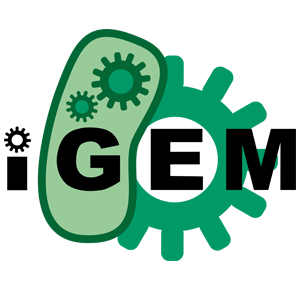Team:UiOslo Norway/Project/Plan
From 2014.igem.org
| Line 6: | Line 6: | ||
<div class="container"> | <div class="container"> | ||
<div class="jumbotron text-center"> | <div class="jumbotron text-center"> | ||
| - | <h1>Project Plan</h1> | + | <h1 style="font-family:Syncopate; color: blue;">Project Plan</h1> |
</div> | </div> | ||
Revision as of 11:40, 17 October 2014
Project Plan

BioBricks
The BioBricks we have attempted to create should give E. coli the ability to bind physically to each other. In order to do this we decided to use the LacZ genes (α and Ω), autotransporter genes and a signal peptide gene. The LacZ α gene existed as a part and we attempted to make the Ω part ourselves. The autotransporter genes were provided to us from our supervisor, Dirk Linke.

LacZ (beta-D-galactosidase)
The β-D-galactosidase, beta-gal or β-gal is an exoglycosidase which hydrolyzes the β-glycosidic bond formed between a galactose and its organic moiety, converting β-galactosides into monosaccharides.
The main substrates of β-D-galactosidases include ganglioside GM1, lactosylceramides, lactose and several glycoproteins.
Furthermore, the protein is a 464kDa homotetramer and every unit of β-D-galactosidase contains five domains, whereas the active site is present on the third domain.
In E. coli the lacZ gene that encodes the β-gal is present as part of the inducible system lac operon which is activated in the presence of lactose when glucose level is low.
In addition, this enzyme has an attribute that is widely used in molecular biology, the α-complementation. It can be split into two peptides, LacZ α and LacZ Ω, none of which is active by themselves. However, once both peptides are properly connected, they restore the functionality. An active enzyme may be detected using X-gal, which forms an easily detectable blue product after cleavage by β-gal, thus providing an easy way to distinguish between the presence or absence of a cloned product in a plasmid.
Autotransporter (AT)
The autotransporter domain is a structural domain found in a large and diverse superfamily of some bacterial outer membrane proteins.
Commonly produced by pathogenic Gram-negative bacteria, they are typically virulence factors. Likewise, they are related to infection processes, virulence in pathogenic bacteria, establishment of biofilm, adherence to mammalian cells and toxins secretion.
All ATs have an N-terminal passenger (α) domain that often harbors a virulence function and is either anchored to the cell surface or released into the external space and a C-terminal translocation (β) domain that resides in the outer membrane.
In addition, it has been known that the β domain anchors the protein to the outer membrane and enables transport of the passenger domain into the extracellular space, being presented on the cell surface.
Regardless of the apparent simplicity of the AT pathway, several aspects of its biogenesis and mechanism remain obscure.
In our project we have attempted to use a newly recognized AT, namely EhaJ.

References and further reading
A. Nath et al. Production, purification, characterization, immobilization, and application of β-galactosidase: a review. Asia-Pac. J. Chem. Eng., 2014.
Ann-Marie Broome, Nihir Bhavsar, Gopalakrishnan Ramamurthy, Gail Newton, and James P. Basilion. Expanding the Utility of β-Galactosidase Complementation: Piece by Piece. Molecular Pharmaceutics vol. 7, no. 1, 60–74, 2009.
Benz, I.; Schmidt, M. A. Structures and functions of autotransporter proteins in microbial pathogens. International Journal of Medical Microbiology 301 (6): 461–468, 2011.
Chang, Robert C. et al. Microprinting of Liver Micro-organ for Drug Metabolism Study. Methods in Molecular Biology Volume 671, 2011, pp 219-238.
Dautin N, Bernstein HD. Protein secretion in gram-negative bacteria via the autotransporter pathway. Annu Rev Microbiol. 2007;61:89-112.
Easton, Donna M. et al. Characterization of EhaJ, a new autotransporter protein from enterohemorrhagic and enteropathogenic Escherichia coli. Frontiers in Microbiology, June 2011, vol.2, article 120.
Jack C. Leo, Iwan Grin and Dirk Linke. Type V secretion: mechanism(s) of autotransport through the bacterial outer membrane. Phil. Trans. R. Soc. B 2012 367, March 2012.
Makhlynets, Olga V.; Korendovych, Ivan V.. Design of catalytically amplified sensors for small molecules. Biomolecules 2014, 4, 402-418. Review.
Nathalie Dautin and Harris D. Bernstein. Protein Secretion in Gram-Negative Bacteria via the Autotransporter Pathway. Annual Review of Microbiology, Vol. 61: 89-112 October 2007.
Oomen, C. J.; Van Ulsen, P.; Van Gelder, P.; Feijen, M.; Tommassen, J.; Gros, P. Structure of the translocator domain of a bacterial autotransporter. The EMBO Journal 23 (6): 1257–1266, 2004.
Sandhu, Sardul Singh. Recombinant DNA Technology. I K International Publishing House. p. 116, 2010.
Y. Imura, K. Sato and E. Yoshimura. Micro organ system to test cancer drugs. Anal. Chem., 2010.
 "
"

